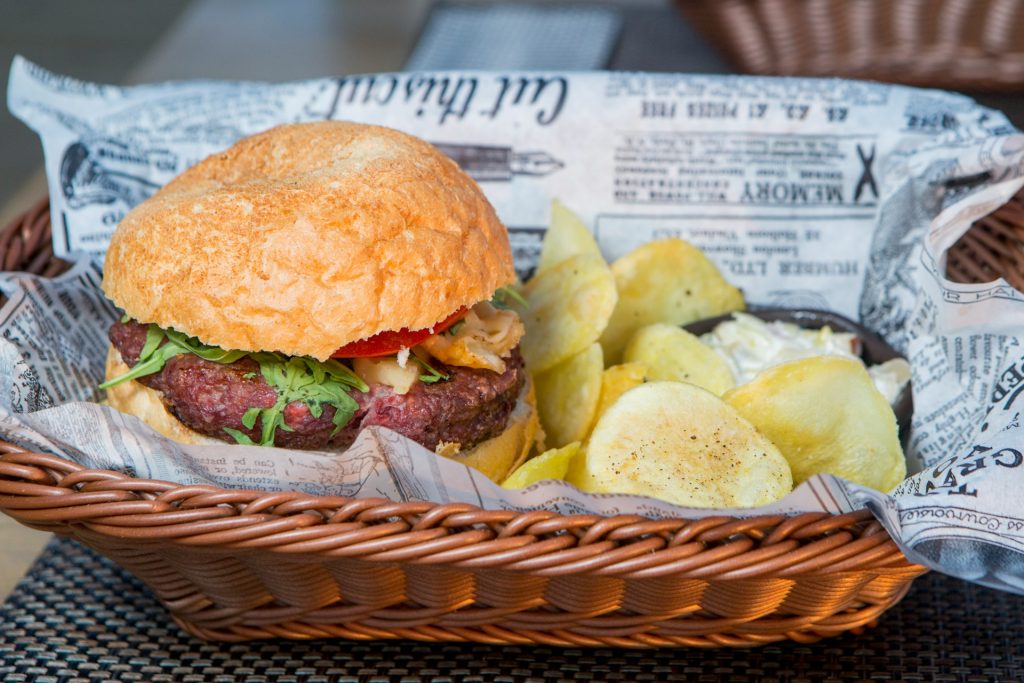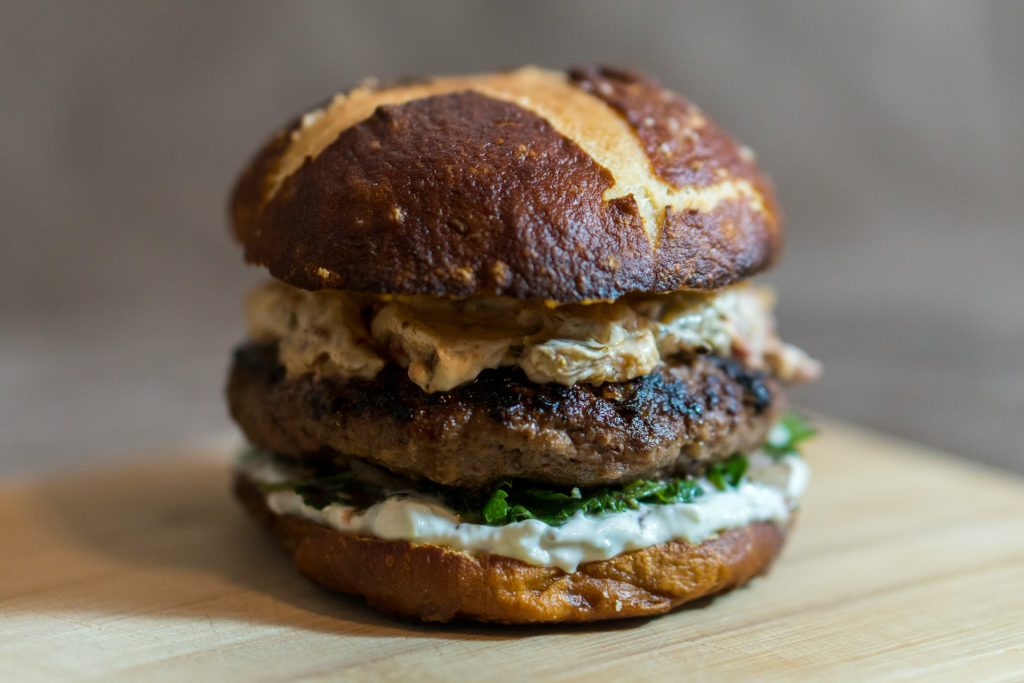Few phrases in the English language are more tempting than “Let’s have a burger.” With Americans devouring 50 billion burgers annually and fueling an industry worth over $100 billion, it’s clear that the humble hamburger is a national treasure. But how did a simple patty of ground beef on a bun become such a beloved icon? Buckle up for a mouthwatering trip through the history of the hamburger, from its ancient roots to its gourmet transformations.

1. Ancient Roots
Did you know the burger might trace its origins back to ancient Rome? Food historians point to a minced meat dish mixed with pine nuts, pepper, and wine as an early precursor to our modern patty. Fast forward a bit, and we find Genghis Khan and his Mongolian horsemen, who are credited with forming scraps of meat into patties for their long journeys. These patties made their way to Russia, where Kublai Khan’s invasion introduced them to Russian chefs. This meat preparation evolved into what we now know as steak tartare and, eventually, the hamburger.
2. Hamburg’s Influence
Ships departing from Hamburg, Germany, brought the concept of “tartare steak” to Russia, where it continued to evolve. The Oxford English Dictionary describes a Hamburg steak as a “hard slab of salted, minced beef, often slightly smoked, mixed with onions and breadcrumbs.” This preparation found its way to food stalls and restaurants in New York City, where German immigrants adapted it to American tastes.
3. The Fairgrounds’ Fracas
One delicious story attributes the hamburger’s name to Charles and Frank Menches, brothers who ran out of sausages at a fair in Hamburg, New York. In a pinch, they substituted cooked ground beef mixed with coffee and brown sugar, serving it between slices of bread. They named it a “hamburger” after the town’s name, turning an improvisation into an American classic.
4. Seymour’s Slice of History
In Seymour, Wisconsin, “Hamburger Charlie” Nagreen was struggling to sell meatballs. To boost sales, he squished the meatballs between slices of bread, creating a portable sandwich he called a hamburger. Seymour proudly claims to be the “Home of the Hamburger,” complete with the Hamburger Hall of Fame. In 2007, Wisconsin’s legislature officially recognized Seymour as the birthplace of the hamburger.
5. Tulsa’s Claim to Fame
Oscar Weber Bilby of Tulsa, Oklahoma, is another contender for the hamburger’s invention. According to Bilby’s descendants, he served the first burger on a bun on July 4, 1891, pairing it with root beer. The burger quickly became a Tulsa tradition, earning the city the title of “Real Birthplace of the Hamburger” from the state governor in 1995.
6. Louis’ Lunch
One of the most celebrated origin stories is from Louis’ Lunch in New Haven, Connecticut. According to the restaurant’s lore, in 1900, a hurried customer asked Louis Lassen for something quick to eat. Louis placed his blend of ground steak trimmings between two slices of toast, creating what we now recognize as the modern hamburger. Louis’ Lunch still operates today, proudly claiming to be the birthplace of the hamburger.
7. Fletcher Davis’ St. Louis Sensation
Fletcher Davis, from Athens, Texas, crafted an early version of the hamburger in the 1880s. However, it wasn’t until he showcased his creation at the 1904 St. Louis World’s Fair that it gained widespread attention. Some people still call Athens the birthplace of the hamburger, adding to the burger’s rich and varied history.

8. Fast Food Revolution
In Wichita, Kansas, two entrepreneurs created White Castle, the first fast-food chain dedicated solely to the burger. Their innovative approach helped lay the foundation for the fast-food industry. Around the same time, The Rite Spot in Pasadena, California, claimed to be the first to add cheese to the burger, a game-changing addition that would become a staple in burger culture.
9. The McDonald’s Empire
The McDonald brothers initially ran a barbecue restaurant in San Bernardino, California. Their shift to burgers transformed their eatery into the world’s largest fast-food chain. Ray Kroc, a struggling milkshake salesman, convinced the McDonald brothers to let him become a partner. After buying them out in 1961, Kroc expanded McDonald’s into a global phenomenon, setting the stage for the burger’s worldwide popularity.
10. Whoppers and Big Macs
Burger King, the world’s second-largest food chain, was founded in Miami and introduced the “Whopper” a decade before McDonald’s launched the Big Mac. This competitive spirit between burger giants has driven innovation and kept the burger industry thriving.
11. Wendy’s Fresh Approach
Dave Thomas, the former head chef of Kentucky Fried Chicken, founded Wendy’s in Columbus, Ohio. Wendy’s introduced a unique full-sized square patty made from fresh beef, breaking away from the traditional round burger format. This innovation further enriched the burger landscape.
12. The Rise of Better Burgers
The “better burger” category emerged with Five Guys, opening in Arlington, Virginia, and focusing on fresh, responsibly sourced ingredients. Shake Shack, founded by restaurateur Danny Meyer in New York City’s Madison Park, followed suit with its smashed beef patties, crinkle-cut fries, and milkshakes. Shake Shack’s rapid expansion and public offering in 2015 solidified its place in the burger hall of fame.
13. Gourmet Innovations
At Smorgasburg in Brooklyn, chef Keizo Shimamoto introduced the ramen burger—ground beef between crispy ramen “buns” seared in sesame oil. This inventive creation quickly became a sensation, showcasing the endless possibilities for burger innovation.
14. Plant-Based Patties
As the demand for plant-based options grew, Sysco began distributing Beyond Burgers, a meat substitute designed to mimic beef’s flavor and texture. Impossible Foods followed suit with the Impossible Whopper at Burger King in 2019, catering to the growing vegetarian and vegan market.
15. The Golden Boy
In the Netherlands, a diner created The Golden Boy, billed as the world’s most expensive burger at nearly $6,000. This extravagant creation features Japanese wagyu beef, Alaskan king crab, white truffles, smoked duck egg mayo, gold leaf, barbecue sauce with Macallan scotch, and beluga caviar, all sandwiched between Dom Perignon Champagne-infused buns.

The hamburger’s history is as multifaceted as the burger itself. From ancient Rome to modern gourmet innovations, the burger has undergone countless transformations, reflecting cultural shifts and culinary creativity. Whether you enjoy a classic cheeseburger or a high-end gourmet creation, the burger’s journey is a testament to its enduring appeal and adaptability. So, next time you bite into a burger, remember you’re savoring a rich and delicious piece of history!





